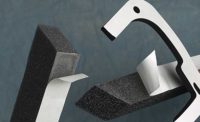Adhesive Bonding
Pressure-Sensitive Adhesive Tapes Can Speed Assembly in Multiple Industries

Acrylic adhesive tapes perform reliably at continuous temperatures up to 400 F. Photo courtesy Avery Dennison Performance Tapes

Acrylic adhesive tapes can be produced in extremely thin dimensions to accommodate the space constraints of modern digital devices. Photo courtesy Avery Dennison Performance Tapes

Acrylic adhesive tapes can replace mechanical fasteners, eliminating the need to drill holes in parts. Photo courtesy Avery Dennison Performance Tapes



Acrylic pressure-sensitive adhesives are becoming the preferred bonding method in a growing number of applications across diverse industries, replacing liquid and spray adhesives, mechanical fasteners and other bonding and fastening systems.
These advanced adhesive tapes have impressive assembly-related and performance characteristics. They withstand high temperatures and harsh environments, and they bond securely to a host of substrates. They enable engineers to lower the total cost of assembly and eliminate time-consuming procedures and cumbersome equipment.
Fast, Accurate Bonding
Easy handling and processing are major advantages of high-performance acrylic adhesive tapes. These tapes can improve the speed and efficiency of assembly operations. They integrate smoothly into automated processes with in-line dispensing equipment and can also be applied by hand. Manual application requires only 8 to 10 pounds of pressure.
Unlike conventional pressure-sensitive adhesives, which tend to bleed at the edges, advanced acrylic adhesives maintain their stability and integrity during processing. They can be placed cleanly and accurately and allow converters to produce complex die cuts and diverse shapes. There is no need to drill or machine parts beforehand as required with mechanical fasteners.
With acrylic adhesive tapes, assemblers and converters can often modify or eliminate outdated processes and equipment, improving the workplace environment. A recent case involved an assembler that had traditionally employed a sprayed adhesive. This required special application equipment and protective gear for workers. After switching to acrylic adhesive tapes, the assembler sped up its bonding operation and eliminated the spray equipment. Workers could do the job in regular clothing.
No Curing Necessary
Hot-melt adhesives need to cool down after application, while conventional liquid adhesives require a curing period ranging from a few hours to an entire day. In contrast, acrylic adhesive tapes bond immediately and require no curing time.
Some acrylic tapes can even be removed after application and repositioned—a benefit in manual assembly operations. This potentially reduces the number of rejected parts.
Pattern coating is an additional benefit. Pressure-sensitive tapes can be supplied with edges that are free of adhesive or with alternating adhesive and nonadhesive tape sections. This can facilitate converting and enable cleaner handling by end users.
Consumer Electronics Applications
The performance features of acrylic tapes, especially strong adhesion and low outgassing, make them ideal for various consumer electronics applications. The tapes can be produced in extremely thin dimensions to accommodate the space constraints of modern digital devices.
Hard disk drives are a notable example. Acrylic tapes meet the application’s requirements for chemical cleanliness and can be accurately shaped to fit different drive configurations. The tapes help protect the disk drives from heat and vibration during use.
Other consumer electronics applications include light-blocking tapes for computer and device screens, optically clear tapes that limit distortion, and lens protection tapes to prevent damage from dirt and scratches. Also, thermally conductive acrylic tapes have been developed to transfer heat from LEDs and other heat sources to reduce operating temperatures.
Automotive Uses
Acrylic adhesive tapes also exhibit excellent high-temperature characteristics and robust resistance to harsh substances and materials—properties that equip them for many automotive applications. The tapes perform reliably at continuous temperatures up to 400 F and intermittent temperatures up to 450 F. They also function well under load, such as when applied around corners.
Low-surface-energy (LSE) materials, such as polypropylene, polyethylene and other engineered plastics, have proliferated in automotive applications, but they pose problems for conventional adhesives. Acrylic adhesive tapes offer a better solution. They bond securely to LSE materials and can even bond two LSE materials together.
In addition, these tapes absorb plasticizers without losing their special properties. Plasticizers found in many engineered films and foams cause rubber-based and other pressure-sensitive adhesive chemistries to break down and soften.
Automotive manufacturers are specifying acrylic adhesive tapes in passenger compartment, exterior and underhood applications. For example, they are being used for attaching trim components, replacing mechanical fasteners and eliminating holes that can allow moisture or liquids to enter and be a starting point for rust. The tapes are used in tandem with damping materials or can be engineered to damp noise and vibrations produced by vehicle systems. The result is a quieter driving experience.
In brake shim applications, acrylic adhesive tapes bond together two stiff materials: the metal shim and brake pad. Here, the adhesives can be stacked in such a way to dissipate vibrations at certain temperatures and prevent noises emanating from the brake assembly.
Acrylic tapes that produce little or no volatile organic compounds find use in applications that require anti-fogging properties. These are earmarked for interior applications to improve air quality and prevent fogging on the windshield from the gradual release of volatile organic compounds.
Appliance Applications
Appliance applications also call for adhesives that can withstand high temperatures and resist damage from harsh substances. Acrylic adhesive tapes are finding increased use in dishwashers, washing machines and dryers. They securely attach sound-damping foams and stiffeners in these appliances, reducing noise and vibration. They can replace mechanical fasteners in areas such as control panels, eliminating the need to drill holes in parts, speeding assembly.
Additional appliance applications include ovens, cooktops and microwaves. Here, acrylic adhesive tapes maintain strength despite exposure to vegetable oils, food acids and other harsh substances.
ASSEMBLY ONLINE
For more information on assembly adhesives, visit www.assemblymag.com to read these articles:
Looking for a reprint of this article?
From high-res PDFs to custom plaques, order your copy today!









